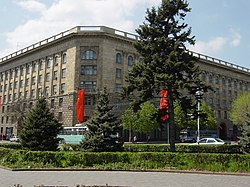Волгоградский Государственный Медицинский Университет | |
 | |
Former name | Stalingrad Medical Institute Volgograd Medical Academy |
|---|---|
| Motto | Symbolum Sanitatis |
| Type | Public |
| Established | 1935 |
Officer in charge | Rector - Vladimir I. Petrov |
| Vice-Chancellor | Aleksandr A. Spasov |
| Rector | Vladimir I. Petrov |
| Dean | Dmitry N. Yemelianov (For international students) |
Administrative staff | 763 highly qualified professors and instructors |
| Students | 5000 citizens of Russia and 900 international students |
| Location | , , Russia 48°42′25″N44°30′54″E / 48.70694°N 44.51500°E |
| Campus | Multiple campuses |
| Website | http://www.volgmed.ru/ |
 | |
Volgograd State Medical University is located in Volgograd which is situated in the southern part of Russia on the west bank of the Volga River. It started as Stalingrad Medical Institute founded in 1935. In 1993 it received the status of the Academy, and in 2003 it was granted the status of the University. It's ranked 88th of all high schools and 15th of medical schools in Russia. [1]
Contents
- Colleges and Departments of the university
- Teaching
- Facilities
- University campus
- Accommodation
- Sports, Social and Cultural facilities
- Student welfare
- References
- External links
The University is accredited by the Russian Ministry for Education for the teaching of both Russian and overseas students. Since 2000 the Volgograd State Medical University has got an opportunity to teach foreign students in the English language.[ citation needed ]